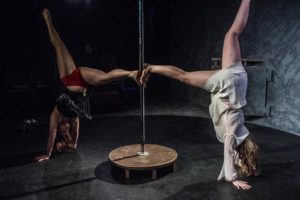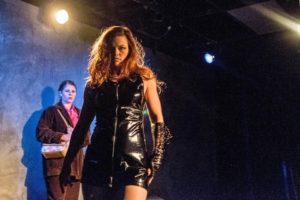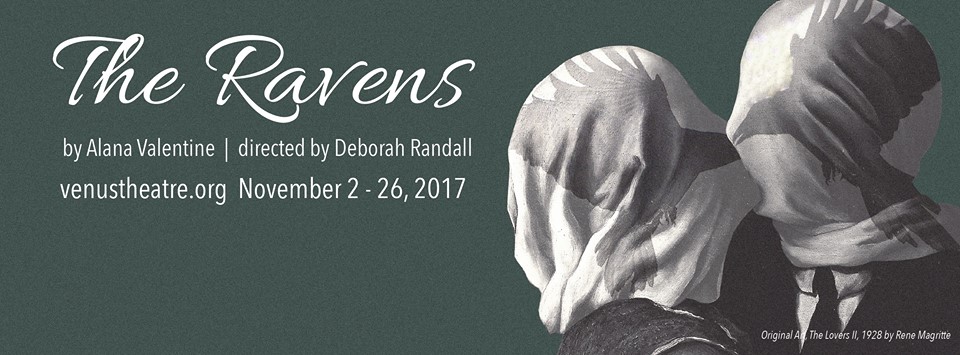Beauty, truth, and rarity, grace and all simplicity; but what happens when Shakespeare is displaced in favor the sex-worker industry where beauty becomes filth, truth becomes the cold, hard reality of drugs and prostitution, and rarity is the kindness of a stranger from a world outside of unending night? In a visually poetic and evocatively moving new work, The Ravens— making its United States premiere— opens as script number 62 and the final production of Season17, “To a T! Love Notes to a Friend”, at Venus Theatre. Written by Australian playwright Alana Valentine and Directed by the founding and presiding Artistic Director Venus, Deborah Randall, The Ravens explores the life of unyielding addiction, unrelenting poverty, and unsavory characters that are articulated with raw essence through the sharp creativity of the playwright and the brilliant execution of the director and cast.

The intimacy of the venue lends itself to the raw exposure of the lives of these unadulterated characters who have fallen through the cracks. The violence, the unsavory practices and behaviors is thrust right into the face of the audience— aided by the house design team at Venus Theatre. Lights and Set are tackled by Amy Rhodes, who pushes the stripper pole— an integral part of the story both physically and symbolically— to the dead center of the stage and thus builds the world around the glaringly phallic obstacle of the patriarchy and oppression of women in society. Rhodes, who makes clever use of fold-open apparatus— to keep from over-cluttering the narrow play space— hinges a door and display to the wall, making for an easy pop-out chocolate shop when the scene calls for it. Her approach to the lighting is subtle, except for the glaring and nauseating whirl of the red stripper light which is used both to augment the ugliness of Kira’s reality and to highlight the true beauty she finds in her own freedom towards the end of the performance.
Trapping the audience with frenetic pulsation into the underworld that these characters live as their daily lives, Sound Designer Neil McFadden uses urgent soundscapes between scenes and subtle blends of atmospheric noise in the background of active scenes to keep the dizzying whirlwind of King’s Cross, Australia buzzing, thrumming, and omnipotent. This pairs well with the eye-catching costumes, fabricated by Director Deborah Randall, because the show is both aurally and visually cued into the nuances of Australian life. Randall, who wears a third hat in the production as the Properties Mistress, pays exacting attention to detail when staying true to the location and setting of the production. The red 2o-dollar notes look almost authentic enough to pass for proper Australian currency, whilst wadded up in the girls’ fists, passing quickly from one to another.
Each of Randall’s costumes are tailored to a tee, not necessarily to the actors but to the exacting measurements of these character personas into which these talented ladies slip. The careworn knitted cap, and oddly bright patterned dress to show an older character well into their dotage contrasts sharply with the fiery red fringe boots and other bright black vinyl accessories often seen on the Kira character. This is just one of many examples how Randall makes these characters visually accessible to the audience before their lines are ever uttered. Teaming that up with McFadden’s brilliant soundscapes and Rhodes’ highly functional set layout and lighting tactics, the production moves with fluidity through all of its varying production elements.

Randall chooses to keep the show set in Australia and takes it a step further by bringing in a friend of the playwright, currently visiting at the Australian Embassy in DC, to consult on proper Australian dialect. This choice pays of splendidly as the girls have strong, yet intelligible, Australian sounds, making the heavy use of the Aussie vernacular and phraseology glide easily over their tongues and out of their mouths. In addition to giving the show a more authentic sound and feel, this somehow makes the show more broadly accessible, giving it a relatability factor that allows members of the audience to see that terrible situations, lifestyles in which they might find themselves trapped, don’t just happen in their own backyard, showing them that they are not alone.
The show is blocked with precise movements, though there isn’t a feeling of artifice about the movement to the piece. Everything thrums, like the heady rush of heroin through the veins— even in slowly moments, like when exploring the poetry of the mysterious Shakespearean Sonnet, there is a sense of perpetual movement, a rushing of energy that pulsates and blinks inside the actors’ cores, resonating throughout their bodies and bursting up to the surfaces. This collective energy of the piece, harvested from the rich text Alana Valentine has crafted, and channeled through Deborah Randall’s visionary focal lens, drives all four performers to give an extraordinary performance.

There is sharp fight choreography, masterfully set forth by Randall, who wears yet another hat for the production, creating stomach-churning violence between two female characters early on. The abuse, bullying, and ultimately degrading nature of this ‘bashing’ (not a terribly American term) and ‘being bashed up’ is a harrowing showcase of Kira’s reality; this is a reality that is all too prevalent for those stuck inside the worlds of the streets, poverty, addiction, and prostitution; Randall does an exemplary job of capturing its heinous essence in just a few simple knockabout scenes. Coupled with the brutal grotesqueness of violence, is the beauty of Alison Talvacchio’s dance choreography. Talvacchio’s approach to the pole is filled with reverence and grace, showcasing the core strength— both physically and emotionally— needed to pull oneself about on such an apparatus and to do so with such ease and flow is remarkable. Talvacchio tempers these movements, and the visually stunning dance near the show’s conclusion, which features herself, co-star Suzanne Edgar, and the aforementioned pole, is an astonishing contrast— a true thing of beauty— to be juxtaposed against everything ugly Valentine and Randall have unearthed and exposed with this production.

As an ensemble, the quartet of actors perform sublimes with one another, advancing the script, establishing their main characters, and co-existing inside each other’s worlds as dynamic individuals. Ashley Zielinksi and Alison Talvacchio aid tremendously in this element of the performance, not only by tackling their primary characters of Marg and Nancy respectively, but by picking up the slack of other by-standing characters— some with names and several without. Zielinksi is an adept physical actor, showcasing a variety of postures and gaits to make each of her character’s uniquely distinguished from one another. This is particularly noticeable when she plays the elderly woman wheeling Talvacchio— also playing an elderly woman— around. As her main character of Marg, Zielinksi is frightening, bordering on the edges of terrifying in her forceful brutality and overall bullying and aggressive behavior and attitude. Talvacchio, who shows an equal versatility in her character portrayals, shines in her primary character of Nancy, delivering one of the most moving speeches in the production— her character’s form of escape during sex-work, transformation into a free soaring bird.

Suzanne Edgar, as Kira, and Erin Hanratty as Nina, are compelling individuals whose characters could not be more opposite from one another. Hanratty’s character is possessed of a green ignorance that is reflected in her winsome smile and cheerful approach to life, though this quickly shifts as the character is exposed to Kira’s way of living. The pair play exceptionally well off of one another, giving a striking amount to one another to work with in their more intense scenes. Hanratty is compassionate, but tempers this compassion with logic and realism, falling easily into the structural and supportive nature of her character. While Edgar, as the leading protagonist embodies this urchin of the underworld— the desperate, desolate woman that society let slip away— fully and with great vigor. There are harrowing moments— like when Edgar portrays one of Kira’s meltdowns— that tugs hard at the heartstrings and draws forth a myriad of unpleasant emotions, pulling them directly to the palpable surface of the human conscious.
Ultimately an extraordinary performance that is evocative and strikingly well performed, designed, and produced, The Ravens’ US premiere is one for the books and is an intelligent and informative drama that should be seen by all this fall season.
Running Time: Approximately 1 hour and 40 minutes with no intermission
The Ravens plays through November 26, 2017 at Venus Theatre— 21 C. Street in historic Laurel, MD. For tickets call the box office at (202) 236-4078 or purchase them online.

